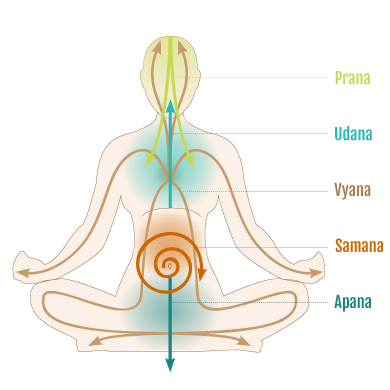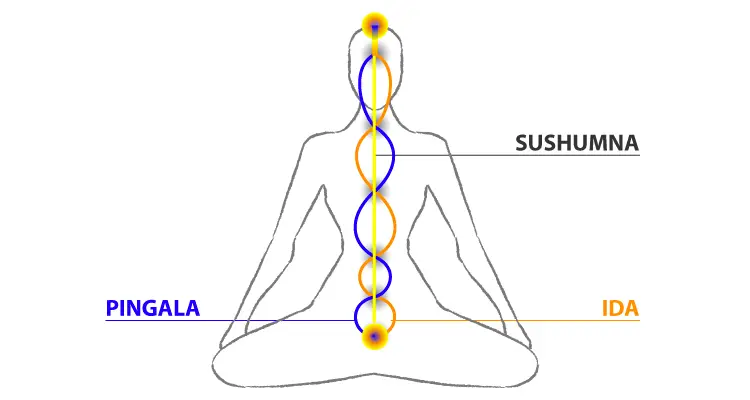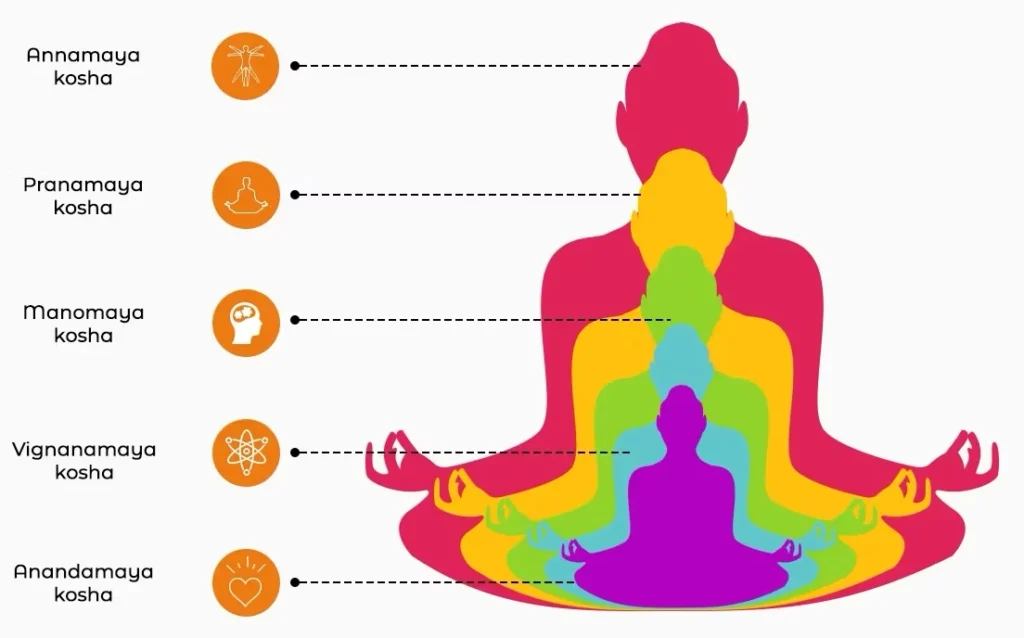The Subtle Body: Prana, Nadis, and Koshas: A Journey Through the Layers of Being
Have you ever felt a rush of energy, an almost unexplainable feeling of lightness? Or perhaps the opposite—a sense of fatigue with a heaviness that seeps through the bones? Although they appear a lot more tiring, these feelings offered deeper insight: there exists another energy system beyond the physical form. This is the subtle body, a quite ancient belief grounded in yoga or Ayurveda traditions.
Your self-perception is not merely creating a material being but instead creating a source of energy with an intricate, pulsating legacy of channels and currents swirling beneath the surface. This is called the Subtle Body, a delicate but potent template that governs our health, emotions, and spiritual evolution.
In this blog post, we will explore the subtle body: its main constituents include
- Prana (life force),
- Nadis (energy channels),
- and Koshas (sheaths of consciousness).
It will shed light on relationships, these components interact in shaping our experiences and how we can create the free flow of energy in us.
1. Prana: The Life Force
Together, let’s go out on this adventure to uncover the dimensions of your being that are concealed from view.
This feeling is the prana: you sitting on the edge of the park, warmth of the sun on your skin, leaves breathing softly under the touch of a gentle breeze. Aliveness, vitality, and connectedness—aren’t they just there? Such a feeling, such an animation, are all of Prana.
According to ancient Yogic and Ayurvedic traditions, Prana represents the vital life force that spreads through everything. It is the respiratory process not merely as breath but as the energy that animates each cell, every thought, and every emotion you hold. Such is an invisible current, causing a connection between you and the Universe, an ages-old power flowing through every living being.
Should the average person ask, “Isn’t prana just a different word for energy?” While close, prana goes beyond the regular scientific definition. Physical energy, as with subtle energies, consciousness, and intention, are all part of its great offer.

Also Read : Mudras and Their Benefits in Yoga
Different Forms of Prana
Like the different streams into which a river breaks up, so prana diverges into other forms inside the body. Notable forms include:
- Prana Vayu: Breath, according to this Prana, governs inhalation, respiration, and circulation.
- Apana Vayu: Responsible for elimination, excretion, and grounding. Below the surface is a downward-moving energy helping us in releasing what no longer serves us.
- Samana Vayu: Found in the area of the abdomen that, in concert with the other Vayus, presides over digestion, metabolism, and transmutation of food into energy.
Prana and Modern Science
Taken at face value, prana might appear as an abstract term. However, it speaks mutually with modern scientific realisation.
Bioelectricity: Bioelectricity describes the functioning of the nervous system and muscle impulses like flowing prana.
Qi: Traditional Chinese Medicine recognises Qi as a vital force within the body, closely aligned with Prana. Both Qi and Prana flow along pathways in the body known as meridians.
Importance of Prana
The quality of our lives directly reflects upon the quality of our prana. When prana circulates freely, we are able to experience:
- Good health: Increased vitality, improved immunity, and continuing resistance against diseases.
- Mental clarity: crisper focus, lesser stress and anxiety, balanced mood.
- Emotional well-being: Improved love for life, peace, and happiness.
Prana and Healing
When prana is imbalanced or blocked, it may manifest as physical, mental, or emotional dis-ease. At this time, yoga, pranayama, and meditation will come in handy.
Cultivation of Prana
Luckily, conscious practices that develop and boost prana include the following:
- Deep Breathing: While simple, this is extremely powerful. Deep-breathing techniques, including diaphragmatic breathing, and pranayama techniques, including Nadi Shodhana, aid in the regulation of Prana flow.
- Yoga Asanas: Many yoga postures, for instance, open channels for energy, such as circulation and the flow of prana throughout the body.
- Mindful Living: Bringing awareness into our daily activities—from eating, moving, and relating to others—helps connect us to our inner energy and allows the flow of prana to be more balanced.
Through the conscious working with Prana, we can not only improve our physical well-being but also deepen our self-awareness and connection with others and their surroundings.
2. Nadis: The Energy Channels
Contemplate Prana to be, in essence, a river of life. The Nadis would be the minutiae-like works of channels that carry that river through the entire system. The Nadis, visible only to the keen-eyed, are said to look like thin light-threads and are the conduits through which Prana flows, hence nourishing all cells and organs.
One way to understand the Nadis is as a subtle anatomy or energy blueprint that underlies the physical body. In other words, even if this channelling is invisible to the human sight, it does influence people’s experiences and health and well-being.

Also Read : The Ultimate Guide to the Benefits of Yoga for Stress and Anxiety
The Importance of the Primary Nadis
They are the primary among many Nadis that hold great importance. They are:
- Ida Nadi: Connected with the moon and feminine energy, Ida Nadi flows on the left side of the spine; this passage serves to release frustration and calm.
- Pingala Nadi: Given the sun and masculine energy, Pingala Nadi has its flow along the right side of the spine; this passage heats and excites.
- Sushumna Nadi: In the centre of the spine is preserved Sushumna Nadi, the highest of all Nadis and the most subtle. It stays dormant in most individuals until it is activated through consistent spiritual practice. Once awakened, Sushumna Nadi allows Kundalini energy to rise freely, helping in states of consciousness on the other hand.
Nadis and Modern Science
Though apparently difficult, the notion of Nadis corresponds with present scientific insights:
- The Nervous System: The extremely complex network of nerves running through the entire body, delivering impulses between the brain and any other organs, is essentially the physical correlate of the Nadi system.
- Acupuncture Meridians: In Traditional Chinese Medicine, acupuncture meridians are, in some way, pathways through which Qi (vital energy) flows. This shows that they are somewhat like Nadis, suggesting some shared level of energetic basis.
The Impact of Nadi Blockages
Blockages or imbalances in Nadi flow may prevent the balanced functioning of the body-mind system, just as a blockage in a river may prevent water from flowing normally. These blockages sometimes show up as:
- physical problems, such as discomfort, stiffness, gastrointestinal problems, and so forth.
- emotional problems, such as lack of focus, impatience, despair, and anxiety.
- mental health problems, such as uncertainty, disorientation, and difficulty making judgements.
Unblocking the Nadis
Thankfully, there are now a variety of techniques that can help clear the Nadis and bring back a balanced flow of energy:
- Yoga Asanas: There are numerous yoga poses that help open energy channels, enhance energy flow, and clear challenges in the Nadis.
- Pranayama: A technique of breathwork that helps to balance the Prana flow through the Ida and Pingala Nadis, e.g., Nadi Shodhana, or alternate nostril breathing.
- Meditation: The practice of meditation calms the mind, soothes the nervous system, and opens the way for the free flow of energy therein.
A regular, balanced flow of energy through the Nadis enhances well-being, nurtures inner peace, and enables self-actualisation.
3. Koshas: The Sheaths of Consciousness
The etheric, physical, energetic, emotional, and spiritual. These layers interact deeply. Yet, much like peeling back an onion, this Yogic tradition speaks to our being as comprising five layers, known as Koshas. There is a deeper essence within each layer. To dissect further or make whole is to invoke the Koshas into play with one another in succession.
The Koshas become a kind of map through which to go in detail and deep into oneself. They provide a framework for investigating all aspects of who we are, ranging from spiritual to physical.

Also Read : Gayatri Mantra: Meaning, Benefits, and Chanting Techniques
The Five Koshas
Let’s peel back these layers together:
- Annamaya Kosha: The Physical Body
The annamaya consists of the physical body subjected to nourishment by food. It is the base on which the other Koshas depend. Proper nourishment for the annamaya is taken from healthy food, exercise, balance in the lifestyle, and rest. This Kosha put much importance on grounding, stability, and the work of taking care of our physical vessel.
- Pranamaya Kosha: The Pranic Body
The Pranamaya Kosha is the layer that houses the energetics that exist beyond the physical body. Prana, the breath of life power, gets absorbed into it. It is the law governing the movement of energy both inside and outside the body. Deep breathing, yoga poses, pranayama, and other similar practices help promote the flow of energy, balance the pulsing force, and improve health and vitality.
- Manomaya Kosha: The Mental Body
The Manomaya Kosha pertains to the mind and includes ideas, feelings, and interior experiences. We process, interpret, and store our experiences there. This layer establishes how reality is viewed in all its facets, including the generation of thoughts. We may process our thoughts and feelings and achieve emotional balance and calm by practicing mindfulness and meditation throughout our lives.
- Vijnanamaya Kosha: The Intellectual Body
We enter this layer, the Vijnanamaya Kosha, as we jump across the frontal surface of the mind. The domain of discriminating, intuition, and understanding of intricate thoughts and concepts will be entrusted to the goddess of intellect, wisdom, and high thinking. It takes intellectual effort, study and experimenting time, and the growth of a critical mind to develop this.
5. Anandamaya Kosha: The Bliss Body
The Anandamaya Kosha, or sheath of bliss, is at the centre of our existence. Joy, calmness, and spiritual understanding are found in pure consciousness. It is the ultimate aim of all spiritual work, a condition of being that is beyond the limitations of the ego and mind.
Understanding the Koshas
We may better understand ourselves, identify areas of imbalance, promote self-awareness, and create a more balanced and connected life by understanding these layers.

Also Read : Yoga for Beginners: Tips and Techniques
The Subtle Body and Modern Science
For a long time, Prana, Nadis, and Koshas were regarded as spiritual and not subject to scientific investigation. However, recent scientific research is starting to shed light on these traditional practices.
The Human Biofield
The human biofield is becoming the focus of the field. This is a reference to the subtle field of energy that surrounds and surrounds the human body. Despite being unnoticed to the human sight, research indicates that this biofield may be quantifiable and play a significant influence in human health and welfare.
The researchers are developing a number of techniques to quantify the biofield, such as:
- Kirlian photography: A technique that records the emissions of subtle energies from living organisms.
- Electrodermal screening: Measures low-level electrical changes that take place within the body’s energy field.
- Magnetoencephalography (MEG): Measures the magnetic fields that result from electrical activity in the brain.
Though still being investigated, these studies certainly indicate that there is more to the human body than meets the eye or more than the physical.
Energy Medicine and the Subtle Body
The emerging field of energy medicine aligns with every aspect of drug efficacy. A holistic approach like this recognises the critical role that subtle energies play in preserving health and well-being.
- Acupuncture: Thin needles are inserted into particular points that might correspond to the Nadis along the body’s meridians during this ancient Chinese medicine practice.
- Reiki: This Japanese healing technique involves the transference of energy from the practitioner to the recipient by means of the hands by use of universal life force (prana-like).
- Therapeutic Touch: It is a practice that heals through a gentle touch that balances the energy flow within a body.
These activities provide a potential position on healing methods that address the energy side of human existence, even though they may still be unknown to Western science.
Another research venture
The subtle body remains under study. Science would mean there is still so much to be learnt about these subtle energies and their influences on health and consciousness.
- Interdisciplinary research: Scientific communities, combined with energy healers and spiritualists, will continue providing extraordinary insights into the nature of subtle bodies.
- Equipment advances: Continued technical advances mean new measurements and analytical procedures will be available with increasing accuracy.
- Integration with conventional medical modalities: The concepts of energy medicine will soon be ready to be added into traditional therapeutic procedures, leading to more comprehensive and effective healthcare approaches.
Approval of these ideas is slow in coming from the domain of conventional science; however, with each passing year and each growing body of research, the more it can be asserted that these ancient wisdom traditions may indeed hold answers to many prominent mysteries of human existence.
Practical Applications
So, how do we balance and care for this complex electromagnetic system known as the Subtle Body? The good news is that being the best in the world is not the only goal here. Rather, the goal is to integrate basic yet meaningful activities into as many little or amazing locations as possible within one’s specific field of vision.
- Cultivating Prana:
Deep Breathing: Conscious breathing is the bedrock upon which Prana cultivation rests. Breathe through the diaphragm a few times; you could do Nadi Shodhana (alternate nostril breathing) a few times; give pranayama a little mindful awareness.
Moving Your Body: Yoga asanas, Tai Chi, and Qi Gong are wonderful ways to move Prana through the body, opening energy channels and releasing blockages.
- Nourishing the Body:
Mindful Eating: Think about the quality and energy of the food you’re taking. Eat foods that are whole and minimally processed as much as you can to nourish the body and mind.
Choose the Healthy Lifestyle: Ample sleep, good exercise, and time in nature should become a priority! These practices support physical health while also opening the channels for the energy to flow freely.
- Cultivating Positive Energies:
Practicing Gratitude: Practicing gratitude each and every day by witnessing all the great things you have in your life.
Mindfulness: Use consciousness toward your thoughts and emotions; gently observe your chain of thoughts without judgement and direct your attention toward positive and uplifting states of thoughts instead.
Be Kind: Acts of kindness and compassion not only benefitted recipients but created a childlike attitude within yourself, for you started feeling good about the fact of having done something good and, above all, displaying your very rare form of energy, your kindness.
- Exploring Spiritual Practices:
- Meditation: Regular practice allows the meditator to become familiar with stillness and calmness of the nervous system to create a good environment for energy flow.
- Chanting and Mantra Meditation: Chanting and mantra meditation can unify the energy centres in the body, providing connection to deeper levels of consciousness.
5. Connecting with Nature:
Spending Time in Nature: Immerse yourself in the natural world. Spend time in parks and forests or by lakes and rivers. Connecting with nature helps to ground us and recharge our energy with the universal life force.
Remember, developing the subtle body is a journey, not a destination. It’s about small and consistent measures on a path toward more awareness and intentionality within daily life.
Conclusion

So, there is the glimpse into the fascinating world of the Subtle Body. Raising the question of what constitutes the life force, which inspires the whole of our being: the network of Nadis that carry this through the Koshas, layers that shroud our consciousness.
It may seem like a draught into the vibrant night, but this trip to one aspect of the Subtle Body’s far richer bandwidth is worthwhile. Gaining knowledge of these subtle energies helps us understand our identity, health, and connection to all people.
There is no alternative to an investigation into the Subtle Body aside from practical application. Breathing with full awareness, yoga, and meditation must become part of our daily lives if we want to establish a working-trueness strong enough for one to grow in balancing Self and energy in our lives.
This internal journey is an ongoing one. There is always more yet to learn, many avenues yet to explore, and layers of consciousness yet to peel back. Enjoy the process; learn to be patient with yourself, and enjoy the unfolding of your journey of self-discovery.






